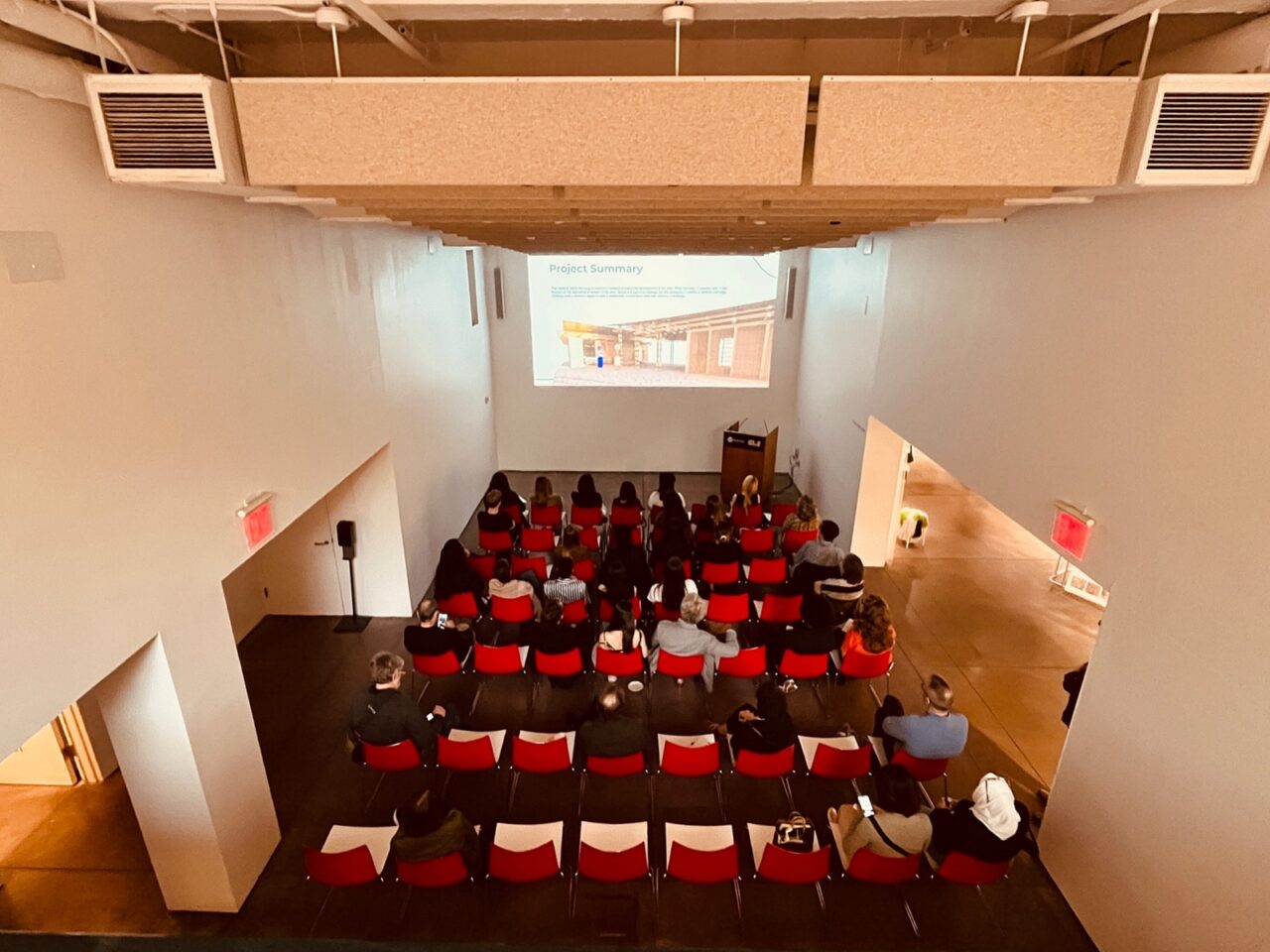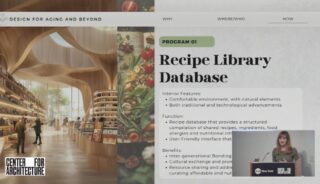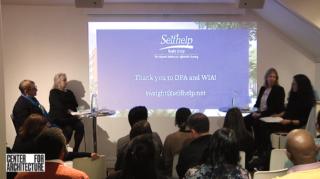Info
-
Co Chairs
-
Kamila Altman, AIA, CPHDCo-chair, 2023–current
-
Chia-Yi Huang, AIA, LEED APCo-chair, 2024-current
-
Nathan Jerry Maltz, AIAEx-officio chair, 2010–2015
-
Rich Rosen, AIAEx-officio chair, 2010–2014
-
Lisa Morgenroth, AIAEx-officio chair, 2014–2016
-
Christine Hunter, AIAEx-officio chair, 2015–2018
-
Brian Pape, AIAEx-officio chair, 2016–2024
-
Ted Porter, AIAEx-officio chair, 2018–2022
-
-
Special Projects
Related Links
- Aging in Place Guide for Building Owners - English
- Aging in Place Guide for Building Owners - Spanish
- Aging in Place Guide for Building Owners - Mandarin
- Top 10 Ways Architects Can Become Age-Friendly
- Urban Design and Architectural Guidelines for an Age-Friendly New York City
- Booming Boroughs
- Design for a Lifetime
- How Communities Can Prepare for the Growing Aging Population (Baylor University)
- Aging in Place Guide Received the 2017 Frederic Schwartz Community Development Award
- VP Citation Awards Aging in Place Guide
- Mayor de Blasio Attends Town Hall Meeting on Senior Housing
- Design and Construction Excellence 2.0 Guiding Principles
- Aging in Place: How Co-ops and Condos Can Address Their Aging Communities
- Local Leaders: Heathier Communities Through Design
- Creating Lifelong Communities in the Atlanta Region
- Housing in America: The Baby Boomers Turn 65
- Best Cities for Successful Aging
- Alzheimer’s Foundation of America
- CB2 Manhattan Senior Service Guide
- American Society of Landscape Architects publishes guide to universal design
- Insights Beyond Vision
- Age-friendly Guide to Manhattan Supermarket
- Aging Artfully
- IMAGE: NYC, the Interactive Map of Aging
- Housing an Aging Population in New York City
- Aging in Place in New York City
- AIA KnowledgeNet Design for Aging
- NYC Architecture Biennial
- Steps To A More Age-Friendly Manhattan
- The Right to Housing with Eric Tars
- Let’s Talk About Light and Health
- Bath’s Comfortably Home Program in Maine
- The Next Retirement Communities Won’t Be Just for Seniors
- Purposeful Placemaking
- Best Living Tech by Lisa Cini
- Infinite Living Secrets of The Werner House
- Pottery Barn Made Some Remarkably Nice Furniture For Senior
- Inclusive Architectural Design for Aging: Learning from Living Out in Palm Springs
Topics
-
December 4, 2024
![Image Courtesy of AIANY DFA]() Image Courtesy of AIANY DFA
Image Courtesy of AIANY DFA![Image Courtesy of AIANY DFA]() Image Courtesy of AIANY DFA
Image Courtesy of AIANY DFA![Image Courtesy of AIANY DFA]() Image Courtesy of AIANY DFA
Image Courtesy of AIANY DFAThe Design for Aging Committee November meeting was delighted to have Kate Leitch from Citizens Housing & Planning Council (CHPC) who presented CHPC’s work related to ADUs (Accessory Dwelling Units). Check out their publications here! And a complete recording of the presentation and discussion can be found here.
We also talked about potential Field Trips. Ted Porter is working with his contact at Marvel to organize a tour of Stonewall House Senior Residences. This would likely happen in the early part of 2025. We agreed that a Friday afternoon trip would be best for most of us. Christine Hunter is working with MAP to organize a tour of Rheingold Senior Residences. Both projects are in Brooklyn so we could potentially combine the two in one day. We will continue to discuss the logistics and update the group once details are firmed up.
Finally, we discussed the NYCHA project that is being revived with DFA funds. We are forming a sub-committee to expand on the study done a few years ago with NYCHA’s Amsterdam Houses. A kick-off meeting is scheduled for 1/30 at 6pm at the Center for Architecture.
Coming up:
- December End of Year Potluck: We will meet on 12/12 (5 – 6:30pm) in person at the Center for Architecture. Feel free to bring food and/or drinks to share!
- January: David Gissen will join our meeting that month. David is the author of The Architecture of Disability and is a professor of Architecture and Urban History at The New School.
- February: Paula Span (a journalist from the New York Times who focuses her writing on aging) will join our meeting that month. Read one of her latest articles here: https://www.nytimes.com/2024/10/07/realestate/senior-move-managers-relocation.html
-
![Image Courtesy of Brian Pape]() Image Courtesy of Brian Pape
Image Courtesy of Brian Pape![Image Courtesy of Brian Pape]() Image Courtesy of Brian Pape
Image Courtesy of Brian Pape![Image Courtesy of Brian Pape]() Image Courtesy of Brian Pape
Image Courtesy of Brian Pape![Image Courtesy of Brian Pape]() Image Courtesy of Brian Pape
Image Courtesy of Brian Pape![Image Courtesy of Brian Pape]() Image Courtesy of Brian Pape
Image Courtesy of Brian PapeOn November 20, the AIANY Design for Aging and AIANY Committee on Residential Architecture were pleased to co-host a cocktail party and conversational workshop at PID Floors Showroom to allow dog-loving designers, puppy-care professionals, and emotionally supportive canine companions to share knowledge and experience gained from successfully creating dog-friendly spaces.
Elaine Santos, Principal, Elaine Santos Design, Christopher Gardner, Principal, TUNA Architecture, and Colin Hunter, Canine Trainer, Dogtown had a conversation in a casual manner with each other. Elaine and Chris spoke to what they take into consideration when designing homes for their clients with dogs. Colin spoke to wellness strategies used by Dogtown for dogs of all types/breeds and ages. In addition to indoor, outdoor design considerations were also been discussed. Each told a story with regards to their professional relationship to designing for or caring for the needs of dogs.
The event was quite a success, where the speakers emphasized the “universal design aspects” that included planning for animals as well as older folks; heights of cabinets, stairs vs. ramps, access routes, avoidance of barriers. The many aspects of mutual benefits of having proper places designed for pets that help the humans too. Having pets at the event also had a special effect on everyone, and it was special for the pet owners to have their pets welcomed to the gathering. -
November 3, 2024
The Design for Aging Committee October meeting was delighted to have Haym Gross, founding member of NYC 2030 District, a non-profit climate partnership focused on building energy and renewable energy, to speak to us about his work with Bridge St. Development Corporation, and Karp Strategies (as well as others) to preserve HUD 202 Senior Supportive Housing in Brooklyn (and beyond). Haym’s team is engaged in studying current conditions at a number of these properties and recommends improvements. Kendall Christiansen (member of the committee) is also involved and talked about his experience on the project as well.
A few resources that were brought up during the meeting include:
- Cadence OneFive: an online platform that can help building owners optimize and understand financial incentives for their building’s energy retrofit needs among other things.
- Heat/ Cool Smart Brooklyn: an example of a successful program administered by NYC 2030 District and sponsored by the Brooklyn Borough President and NYSERDA to help owners retrofit their buildings with envelope improvements and electrification of heat.
We also talked about ideas on how to use DFA committee funds that were recently confirmed by AIANY to be available. The group agreed to move forward with expanding on the study done a few years ago with NYCHA’s Amsterdam Houses. The project focused on ways to better accommodate seniors living in multi-generational communities. One idea is to come up with a prototype that is more applicable to the majority of NYCHA buildings. We will discuss this more at the November meeting to figure out the next steps, so ideas and participation are welcome from interested members as we try to define the project more!
Coming up:
- Next meeting. We will meet on 11/21 from 5-6:30 pm and the meeting will be hybrid. Kate Leitch from Citizens Housing & Planning Council (CHPC) will be presenting the work the organization has been doing related to ADUs (Accessory Dwelling Units). CHPC is a non-profit research and education organization focused on housing and planning policy in NYC.
- December: We will meet on 12/19 in person at the Center for Architecture. The idea would be to have a Holiday potluck get-together! We will discuss this at the November meeting.
-
July 31, 2024
Happy summer! The DFA July Committee Meeting had a heated discussion on the topic of ADUs with new zoning—an opportunity for people to age in place with families. Members expressed interests in ADU zoning changes being offered in NYC and design for aging with ADUs, and brainstormed potential connections with AARP NYC, Jonathan Marvel (affordable housing company), and AIANY Custom Residential Architects Network and/or Housing Committee.
The discussion also covered co-housing projects such as Carehaus which provides aging in place with a sense of community, and NYCHA campus projects like the Atrium at Sumner and Stonewall House that bring different experiences to their residents. The Committee would like to invite related designers and/or residents to share their thoughts.
During the August meeting on 8/22, we will have the pleasure of welcoming NYSID Graduate students who are completing their Master’s in Public Services in Healthcare Interior. Four students will be presenting their capstone proposals:
Sarah – affordable multigenerational housing in East Village
Wenqi – luxury aging-friendly apartments on Highline
Wenfei – new universal design for medical services – nurse station, cabinets, and way-finding
Ashley – hospice for the young population in Puerto RicoSo join us in August!
-
May 27, 2024
![Image Courtesy of Marcela Alvarez, Yuan Fang, Priyashi Mehta, Amy Cul, Jieqi Chen, Alessia Gallo.]() Image Courtesy of Marcela Alvarez, Yuan Fang, Priyashi Mehta, Amy Cul, Jieqi Chen, Alessia Gallo.
Image Courtesy of Marcela Alvarez, Yuan Fang, Priyashi Mehta, Amy Cul, Jieqi Chen, Alessia Gallo.![Image Courtesy of Yutaka Takiura]() Image Courtesy of Yutaka Takiura
Image Courtesy of Yutaka Takiura![Image Courtesy of Yutaka Takiura]() Image Courtesy of Yutaka Takiura
Image Courtesy of Yutaka Takiura![Image Courtesy of Yutaka Takiura]() Image Courtesy of Yutaka Takiura
Image Courtesy of Yutaka TakiuraOn May 9, the AIANY Design for Aging committee was pleased to host Yutaka Takiura, AIA, Associate Professor at Pratt Institute and his students Marcela Alvarez, Jieqi Chen, Chuying (Amy) Cul, Yuan Fang, Alessia Gallo, Isabella Lee, Audrey J. Li, Shijia Ma, Ghezlan A. Al Henaidi, Evie Kaufman, Priyashi S. Mehta, and Chia-Yu (Ariel) Wei from Pratt Institute School of Design‘s Spring 2024 class “Design for Aging and Beyond.” The class conducted in-depth research on social issues and had the opportunity to meet with professionals and organizations outside the classroom. Each student developed a design proposal based on their research and experiments to assist people in need, including the aging population. In this presentation, audience witnessed the students’ exceptional skills and unwavering commitment to social justice:
The students’ projects were really great. And you had a fantastic turnout. – Andrea Lillo
It was good to see all the great work your students were doing! They were all so engaged with their projects and expressive. – Eric Gering
Thank you again for inviting us to a great presentation of your student’s projects. I am glad I was able to attend and take notes as it is a relevant topic for me personally. I thoroughly enjoyed these presentations and have already shared some of what I’ve learned with others outside of the design industry. – Melida Valera
Professor Yutaka Takiura congratulated the students of gaining unique ideas and perspectives to be ready to step outside of the campus and make a real difference. Their ideas and potential have the power to change lives, and we can’t wait to see what they will achieve in the future. A complete replay of their presentation can be viewed here.
Committee Meetings
-
Thu, 1/23, 2025, 5:00pm
Past Events
-
Wed, 11/20/24, 5:00pm
-
Thu, 5/9/24, 5:00pm
-
Tue, 4/2/24, 6:30pm
-
Wed, 3/13/24, 6:00pm
-
Tue, 10/10/23, 6:00pm
























